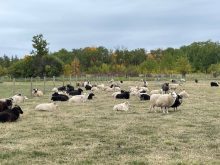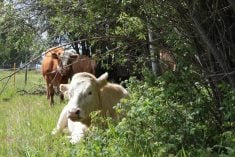One of the serious diseases we see in bison but much less frequently in cattle is MCF or Malignant catarrhal fever, usually resulting from some interaction between bison and sheep.
The MCF family of diseases is seen in 33 species. Clinical signs are a high fever, lethargy and weakness, with ocular and nasal discharge leading to death usually in a few days, even in mature bison. One visual symptom is animals developing a “blue eye”.
Read Also

Cancer agency reclassifies another herbicide ‘probably carcinogenic’
The WHO’s cancer research agency has now put atrazine, a herbicide well known to corn growers, in the same potential-hazard category where the agency put glyphosate.
It is hard to believe this herpes virus carried by innocent-looking sheep causes them no problems but can kill a mature healthy bison. (herpes causes cold sores in humans and IBR in cattle, causing respiratory disease and abortions).
To prevent and control this we need to know prevention strategies, potential risks and how close can sheep come to bison without being a problem. We need to work on neighbourly relationships with sheep producers and the quicker you work on this, the better the outcome.
A high percentage of the sheep carry this virus and will be life-long carriers They usually contract the virus from their mothers shortly after birth. Blood testing, which is an option in smaller flocks, can reveal which ones are carriers.
If bison and sheep are being raised in the same vicinity, a risk factor needs to be determined. Ideally, there should be a buffer zone of several kilometres between sheep and bison as the virus can have airborne distribution. How many and what class of sheep are in the area, the distance from the bison, whether the bison are downwind or upwind from the sheep and whether there is a “biofilter” (windbreak of trees or bush) between the two species are all factors to consider.
Feeder lambs excrete the most virus. Second would be ewes around the time of lambing when they are immuno-suppressed. These two classes of sheep are for sure the groups we need separated with as much distance as possible.
Good communication needed
This is where co-operation between bison and sheep producers goes along way. I have seen bison and sheep producers making sure pastures are rotated to ensure maximum distance between the species. When shipping sheep to market, the route should avoid going near bison if possible.
It has been found that distance of around three kilometres or more between the species is necessary to minimize risk, and ideally the sheep should be downwind from the bison.
In this country, most winds are from the north to northwest so it would be best if sheep were raised to the south or southeast of the bison. I realize we do not often have a choice. Planting thick rapid-growing windbreaks will create a biofilter and may be good at preventing other highly mobile contagious diseases as well. This is where forested areas can be good at preventing viral diseases that may be spread in the wind.
Bison can also be exposed to this virus if they are transported in the same truck that recently carried sheep, or held in auction market pens that recently held sheep.
Continual education is needed to remind sheep and bison producers that bison could contract this disease at any time, with severe consequences. Treatment options are usually unrewarding. Prevention is the key. It is worthy to note that goats will not affect bison. They carry another herpes virus that seems to have no ill effects on bison.
There is a thought that bison with a very low exposure to sheep might develop immunity over time, but not enough research has been done on this. A critical question is how much exposure becomes protective and how much exposure is too much.
In my experience, mature animals are more susceptible than young stock. The good news is that bison will not transmit MCF between each other. Exposure to the sheep or where they have been that’s the problem. And the more the sheep, the more the risk. Across the industry the risk can range from a flock of 10 sheep to a feedyard of 5,000 head of lambs.
There is no vaccine against this disease and there may never be one because of the low demand and economics. While it is serious for those affected, in reality there are only a few instances where bison and sheep are in close proximity. There may never be a push to develop a vaccine unless the sheep population grows substantially in Canada.
I would recommend anyone interested in raising bison not to purchase land close to a large sheep operation. If a sheep producer moves in next door to a bison operation the operators should start the conversation of how damaging MCF can be. We rarely see MCF in cattle. In my experience, it occurs on an individual animal basis so perhaps that particular cow was immunosuppressed in some way.
It is important to be ever cognizant of the non-compatibility of sheep and bison. By educating everyone on how it spreads hopefully we can keep its presence to a minimum.















